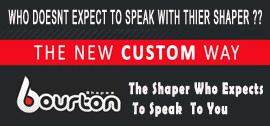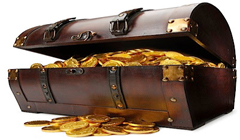AUSTRALIA’S BEST SHAPERS SERIES
Murray is as part of the surfboard shaping masters as you can get. After his start in the ‘70s he’s become interwoven in countless modern board makers like DHD and JS. His infamous Pipedream store on the Gold Coast has been a must visit for many of the world’s top surfers. His custom high performance and retro shapes are smooth as silk under most surfers’ feet and he continues to carve magic sticks to this day, and did you know he was one of the first to surf, and name Lakey Peak!? Here’s Murray’s story, interview by Hugh Wyllie:
What do Troy Brooks, Luke Munro, Ry Craike, Zane Harrison, Chappy Jennings, Ross Clarke Jones, Tony Ray and a swag of Currumbin’s best local rippers have in common? One, they’ve all ridden Murray Bourton’s surfboards, and two, we bet every last one of them could mow a blank with their eyes closed! That’s because a custom order with Muzz is less of a phone call, and more of a masterclass. Seriously, the man’s a trueblue teacher of templates, from Pipedreams, to Base, to Bourton Shapes; Muzz is ready to show you what goes into the foam under foot. So get cosy, grab a pen, maybe a planer… Murray’s masterclass is in session.
CW: Tell us Murray, how did you first get into shaping?
MB: I was surfing on the west coast of Victoria back in the early 60s. From there I flew over to Queensland in 1970 and fell into a job with an old mate up at Currumbin. I think he saw it as an opportunity to go ‘I’ll teach this young kid, and he can do all the work and I’ll just swing on my hammock and use my index finger,’ which worked out ok and I learnt some basics. Then the boss went overseas so I started making boards on my own and gradually worked into a fulltime job shaping. So I’m basically self-taught. In those years, Gordon Merchant’s shapes inspired me. He invented the tucked edge rail and it’s still used to this day; you could say he mentored me from a distance.

Testing Indo Guns at G Land in the 1970s
For a time there half the Quiksilver stable had your boards under their feet. Troy Brooko, Luke Munro, Ry Craike, Ross Clarke Jones. How did shaping for a high profile team influence your designs?
With a lot of these guys, I knew their parents really well. I didn’t come out of the egg wanting to be a shaper for the stars, running around contests and kissing babies. I’ve seen a lot of surfboard shapers market themselves out of business, and I was more interested in making boards for guys that could give me really good feedback. What I did learn more than anything is that one man’s trash is another man’s treasure. Here you had guys exactly the same weight, unable to ride one another’s boards. So I had to develop specific designs that suited them, by listening very carefully to their feedback. Sometimes you’d throw some wildcards at them and sometimes they’d ride them very well.
Over time you understand that everyone is completely different so you simply can’t have one size fits all, especially amongst those top guys; they’re all so particular, and quite rightly. The tool they are riding can define winning or losing. The guys that are winning seem to ride a magic board, and that’s a confidence thing; it’s in the head. If they trust this one and not this one, they’ll do things. In search of that, they go and ride other people’s boards. Imagine Occy going to Gordon Merchant and saying, ‘Look these boardshorts give me a rash so I’m gonna wear these Quiky boardshorts, I just took the tag off and put the Billabong on there, is that cool Gordon?’ Well it wouldn’t be with him but it had to be with us shapers. It’s all part of the experience. I’ve been sponsoring guys since way back like Chappy Jennings, and they didn’t dick around like that.
CW: Do you see a difference in your skills as a craftsman now after shaping high performance crafts for the top athletes on tour?
One thing I didn’t agree with was shaping boards for those guys through that period was all their surfboards were so much alike. Basically, there was a model, with differences like a bit more concave or the tail’s a bit wider but they were all of the same ilk, and we weren’t moving forward in design, because they were all stuck on the needle thruster and it had to be light but they all had subtle variations. We weren’t going out there busting out totally different designs because they were all too scared to surf them. The only guy who wasn’t scared was the guy who had the most confidence – Kelly Slater. So he could try anything, and that was a confidence thing. Design didn’t really go forward until guys like Dane Reynolds, Rasta and Ozzie made it cool to ride other stuff and could really rip on it. From that day on we didn’t need to offer a free snorkel with every surfboard we sold, because we knew it would float the customer.

Murray takes down Uluwatu in the 90s
Are you able to push the boundaries further these days? What have you been working on recently?
I make good surfboards for good surfers, which allows me a little more freedom to make suggestions a little more left of centre. I was at the forefront of second generation quads, which really would have died a slow grisly death if Kelly hadn’t accepted the design and made them popular. My business demography is older guys who still rip. A lot of my success really is about being able to make wider boards that are quite short for guys who might be 45 or 50 who have always been good surfers but are maybe getting a bit tight in the joints or getting to their feet a bit slower, but once they’re up, they rip like they always have.
Quads allow that because you can have quite a long board that doesn’t spin out. With those two fins on the rail, I find quad setups have the grip of a pitbull and it changed my design emphasis to making boards that are really short. I don’t think boards would have gone quite as short and wide if the facility of quads were not there to allow it. A lot of my designs are really built around this concept.
CW: What about your work alongside Simon Anderson and Darren Handley? Have those two craftsman influenced your approach to design in any way?
When Base finished, Simon went his way, I went mine, and Darren had to continue on the high end because that’s how he markets himself. I think we all understood that until you learn what the guy’s been riding you can’t take him forward. You need to know what he’s leaving behind. Those are the conversations that matter, and that’s what I specialise in. This is a service that bigger brands do not offer, because they’re simply too busy to have a one on one conversation. You might get to talk to the ghost shaper, but that’s not what the customer is after when they’re paying top dollar for a custom order. So I almost work as a surfboard doctor for people who get lost or can’t decide from all these shapes on the market. There’s just so much choice and people don’t really know what to go for anymore, unless they want to clone themselves after Julian Wilson and get the Julian Wilson model, but that’s becoming less and less relevant because I think people are now realising that those top guys are extraordinary.
What’s the most rewarding part about having that one on one experience with the customer?
The satisfaction levels have been really high. I’m doing 15 to 20 boards a week, I offer good service and I listen to people’s needs, and that’s something rare. The Internet has made this process even faster and now I can actually serve people as good as if I was on the shop floor with them. Providing people answer all the questions, and we can have that conversation on the phone, I send them pdf files and all the designs. The great thing about this interaction is a lot of these people are starting to understand the actual numbers of their boards,
‘yes ok, nose this, tail this, volume this’. They’re getting an education in design In fact I’ve got guys now off the back of the files I sent them, they’re coming back six months later and saying ‘Muzz ok, I want the same board again but I to put the nose down from 5 ¼ to 5 7/8 and I want…” and they’re designing the surfboard themselves and I love that. I like that they consider more elements to the design rather than just the length, tail shape and the litreage; they’re learning. They know what nose lift does, because they’ve learnt it, by making the decisions themselves, they’re becoming designers, which is great. This is what the new customised is all about. I’m talking to guys at Kalbarri, Townsville and they’re getting really good service with just a laptop or a mobile phone.
MURRAY RECOMMENDS: (L-R) The Silver Bullet, The HPS-EPS and The Dixi Spoon


The modern and mobile office of Bourton Shapes

Off the top at Kirra in the 70s

Murray surfs Lakey Peak as one of the first; he named the now famous surf spot!
See original here : http://www.coastalwatch.com/surfing/20831/australia-s-best-shapers-who-is-murray-bourton

